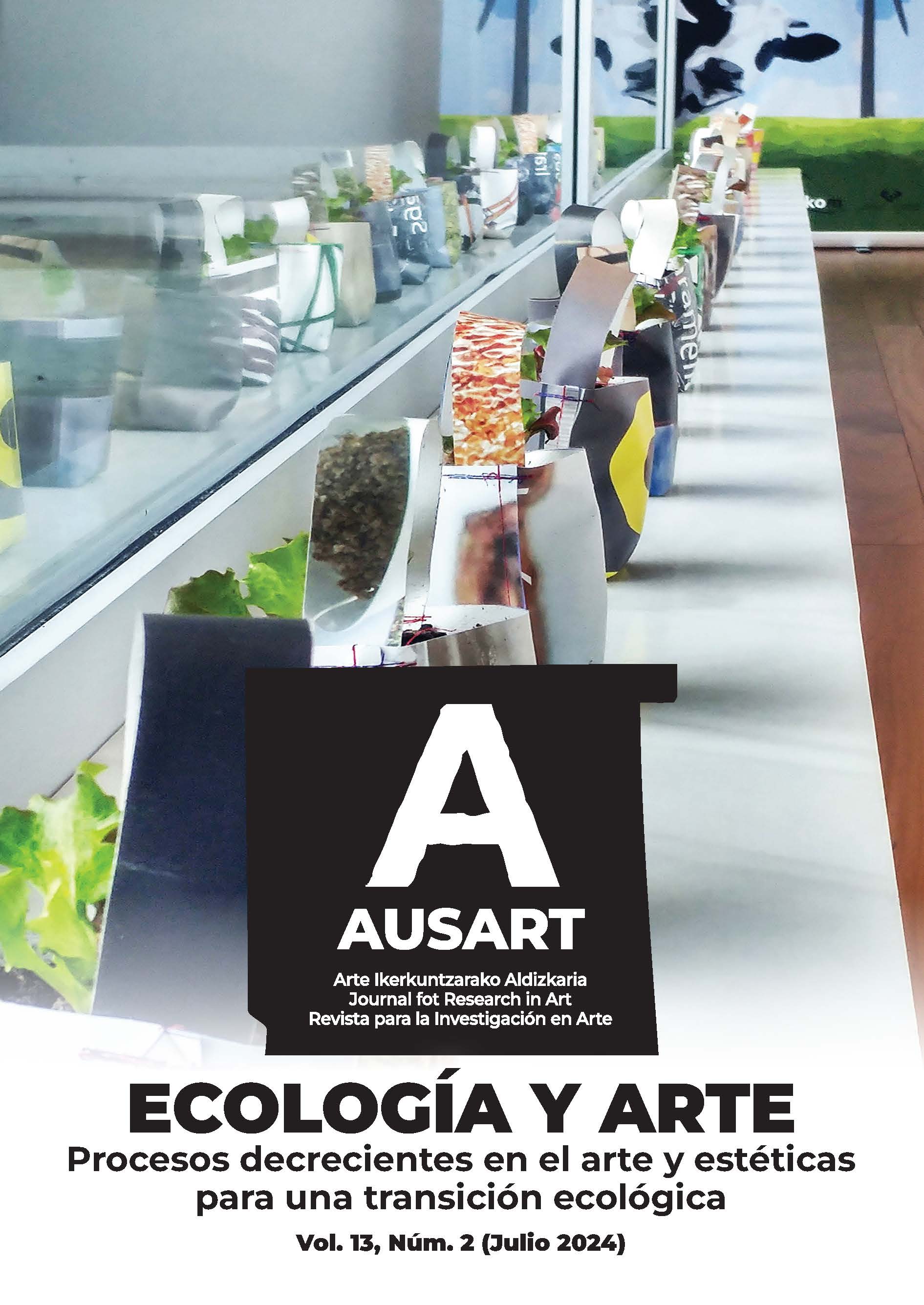«Ghostly plants of damaged words» Phytoremediation artistic project study about Jesenice Slovenian city soil or how to see the soil as a model of artistic ecology
##plugins.themes.bootstrap3.article.main##
##plugins.themes.bootstrap3.article.sidebar##
Resumen
«Ghostly plants of damaged world» —a biomedia installation— offers a particular vision of the crossroads between technology and ecology. Biomedia refers to any media system with attitudes similar to those of the non-human.Through invocations of scientific knowledge and techniques, this research-creation raises the limits of our understanding of what constitutes soil typology. By presenting the mutation of an albino plant and the mutualism of mycorrhizae, the work reminds us that ecology is not just an attention to our uses, but a relational attention. From this approach, we will focus on the research methodology and creative stages involved in the work, and the knowledge contributed.
Cómo citar
##plugins.themes.bootstrap3.article.details##
Druzina, Branko & Andrej Perc. 2010. «Sites in the Republic of Slovenia polluted by heavy metals: Strategy and actions planned». Proceedings of the Annual International Conference on Soils, Sediments, Water and Energy: 12. https://n9.cl/t2pcso
Haraway, Donna Jeanne. 2015. «Sympoièse, sf, embrouilles multispécifiques». Dans Gestes spéculatifs, édité par Didier Debaise & Isabelle Stengers; traduit par Isabelle Stengers, Benedikte Zitouni & Vinciane Despret. Paris: Les Presses du Réel
Harries, John G. 1981. «Personal computers and notated visual art». Leonardo 14(4): 299-301. https://doi.org/10.2307/1574606
Hauser, Jens. 2016. «Biomediality and art». Dans Recomposing art and science: Artists-in-labs, edited by Irène Hediger & Jill Scott. Berlin: De Gruyter https://doi.org/10.1515/9783110474596-021
Luquet-Gad, Ingrid. 2024. «Alizée Armet: De l’hybride à l’hyperlink (et aller-retour)». Lequotidiendelart.com, 22 fév. https://n9.cl/vnho5
Mitchell, Robert. 2010. Bioart and the vitality of media. Seattle WA: Washington University
Nahon, Daniel B. 2008. L’épuisement de la terre: L’enjeu du XXIe siècle. Paris: Odile
Simondon, Gilbert. (1983) 2014. «Trois perspectives pour une réflexion sur l'éthique et la technique». Dans Sur la technique (1953-1983), 337-351. Paris: Presses Universitaires de France
Simondon, Gilbert. 2005. L’invention dans les techniques: Cours et conférences. Édition établie et présentée par Jean-Yves Chateau. Paris: Seuil
Springer, Anna-Sophie & Etienne Turpin. 2015. «A new image of soil». Dans Land & animal & nonanimal 2 (intercalations), 69-73. https://n9.cl/af03v
Stapleton, Tom. 2017. «The effects of heavy metal nickel on albino redwood chimeras» Chimeraredwoods.com. https://n9.cl/anpvrr
Steyerl, Hito. 2009. «In defense of the poor image». E-Flux 10: 210-217. https://n9.cl/p8m9r
Taji, Acram M., William A. Dodd & Richard R. Williams. 1990. «Propagation of Australian plants by tissue culture». Australian Horticulture 889: 89–92
Thacker, Eugene. 2004. «What is biomedia? ». Dans Biomedia, 1-33. Minneapolis MN: University of Minnesota. https://doi.org/10.1353/con.2004.0014
Thipnet, Phakhamon, Pichan Sawangwong, Chaisak Issro & Thanawee Chodjarusawad. 2016. Ajer 5(11): 285-296. https://n9.cl/0uzyy
Tsing, Anna Lowenhaupt, Heather Anne Swanson, Elaine Gan & Nils Bubandt, eds. 2017. Arts of living on a damaged planet: Ghosts and monsters of the Anthropocene. Minneapolis MN: University of Minnesota
Yetisen, Ali K., Joe Davis, Ahmet F. Coskun, George M. Church & Seok Hyun Yun. 2015. «Bioart» Trends in Biotechnology 33(12). https://doi.org/10.1016/j.tibtech.2015.09.011

Esta obra está bajo una licencia internacional Creative Commons Atribución-CompartirIgual 4.0.

Atribución-CompartirIgual 4.0 Internacional (CC BY-SA 4.0)
Usted es libre de:
- Compartir — copiar y redistribuir el material en cualquier medio o formato
- Adaptar — remezclar, transformar y construir a partir del material para cualquier propósito, incluso comercialmente.

